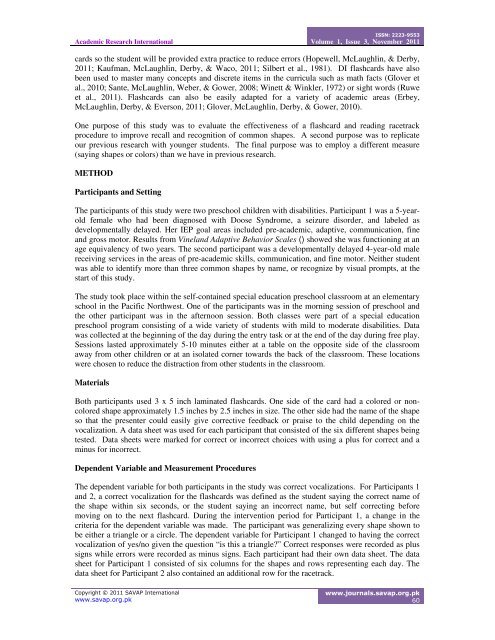the effects of direct instruction flashcards on shape recognition and ...
the effects of direct instruction flashcards on shape recognition and ...
the effects of direct instruction flashcards on shape recognition and ...
You also want an ePaper? Increase the reach of your titles
YUMPU automatically turns print PDFs into web optimized ePapers that Google loves.
Academic Research Internati<strong>on</strong>al<br />
ISSN: 2223-9553<br />
Volume 1, Issue 3, November 2011<br />
cards so <str<strong>on</strong>g>the</str<strong>on</strong>g> student will be provided extra practice to reduce errors (Hopewell, McLaughlin, & Derby,<br />
2011; Kaufman, McLaughlin, Derby, & Waco, 2011; Silbert et al., 1981). DI <str<strong>on</strong>g>flashcards</str<strong>on</strong>g> have also<br />
been used to master many c<strong>on</strong>cepts <strong>and</strong> discrete items in <str<strong>on</strong>g>the</str<strong>on</strong>g> curricula such as math facts (Glover et<br />
al., 2010; Sante, McLaughlin, Weber, & Gower, 2008; Winett & Winkler, 1972) or sight words (Ruwe<br />
et al., 2011). Flashcards can also be easily adapted for a variety <str<strong>on</strong>g>of</str<strong>on</strong>g> academic areas (Erbey,<br />
McLaughlin, Derby, & Evers<strong>on</strong>, 2011; Glover, McLaughlin, Derby, & Gower, 2010).<br />
One purpose <str<strong>on</strong>g>of</str<strong>on</strong>g> this study was to evaluate <str<strong>on</strong>g>the</str<strong>on</strong>g> effectiveness <str<strong>on</strong>g>of</str<strong>on</strong>g> a flashcard <strong>and</strong> reading racetrack<br />
procedure to improve recall <strong>and</strong> recogniti<strong>on</strong> <str<strong>on</strong>g>of</str<strong>on</strong>g> comm<strong>on</strong> <strong>shape</strong>s. A sec<strong>on</strong>d purpose was to replicate<br />
our previous research with younger students. The final purpose was to employ a different measure<br />
(saying <strong>shape</strong>s or colors) than we have in previous research.<br />
METHOD<br />
Participants <strong>and</strong> Setting<br />
The participants <str<strong>on</strong>g>of</str<strong>on</strong>g> this study were two preschool children with disabilities. Participant 1 was a 5-yearold<br />
female who had been diagnosed with Doose Syndrome, a seizure disorder, <strong>and</strong> labeled as<br />
developmentally delayed. Her IEP goal areas included pre-academic, adaptive, communicati<strong>on</strong>, fine<br />
<strong>and</strong> gross motor. Results from Vinel<strong>and</strong> Adaptive Behavior Scales () showed she was functi<strong>on</strong>ing at an<br />
age equivalency <str<strong>on</strong>g>of</str<strong>on</strong>g> two years. The sec<strong>on</strong>d participant was a developmentally delayed 4-year-old male<br />
receiving services in <str<strong>on</strong>g>the</str<strong>on</strong>g> areas <str<strong>on</strong>g>of</str<strong>on</strong>g> pre-academic skills, communicati<strong>on</strong>, <strong>and</strong> fine motor. Nei<str<strong>on</strong>g>the</str<strong>on</strong>g>r student<br />
was able to identify more than three comm<strong>on</strong> <strong>shape</strong>s by name, or recognize by visual prompts, at <str<strong>on</strong>g>the</str<strong>on</strong>g><br />
start <str<strong>on</strong>g>of</str<strong>on</strong>g> this study.<br />
The study took place within <str<strong>on</strong>g>the</str<strong>on</strong>g> self-c<strong>on</strong>tained special educati<strong>on</strong> preschool classroom at an elementary<br />
school in <str<strong>on</strong>g>the</str<strong>on</strong>g> Pacific Northwest. One <str<strong>on</strong>g>of</str<strong>on</strong>g> <str<strong>on</strong>g>the</str<strong>on</strong>g> participants was in <str<strong>on</strong>g>the</str<strong>on</strong>g> morning sessi<strong>on</strong> <str<strong>on</strong>g>of</str<strong>on</strong>g> preschool <strong>and</strong><br />
<str<strong>on</strong>g>the</str<strong>on</strong>g> o<str<strong>on</strong>g>the</str<strong>on</strong>g>r participant was in <str<strong>on</strong>g>the</str<strong>on</strong>g> afterno<strong>on</strong> sessi<strong>on</strong>. Both classes were part <str<strong>on</strong>g>of</str<strong>on</strong>g> a special educati<strong>on</strong><br />
preschool program c<strong>on</strong>sisting <str<strong>on</strong>g>of</str<strong>on</strong>g> a wide variety <str<strong>on</strong>g>of</str<strong>on</strong>g> students with mild to moderate disabilities. Data<br />
was collected at <str<strong>on</strong>g>the</str<strong>on</strong>g> beginning <str<strong>on</strong>g>of</str<strong>on</strong>g> <str<strong>on</strong>g>the</str<strong>on</strong>g> day during <str<strong>on</strong>g>the</str<strong>on</strong>g> entry task or at <str<strong>on</strong>g>the</str<strong>on</strong>g> end <str<strong>on</strong>g>of</str<strong>on</strong>g> <str<strong>on</strong>g>the</str<strong>on</strong>g> day during free play.<br />
Sessi<strong>on</strong>s lasted approximately 5-10 minutes ei<str<strong>on</strong>g>the</str<strong>on</strong>g>r at a table <strong>on</strong> <str<strong>on</strong>g>the</str<strong>on</strong>g> opposite side <str<strong>on</strong>g>of</str<strong>on</strong>g> <str<strong>on</strong>g>the</str<strong>on</strong>g> classroom<br />
away from o<str<strong>on</strong>g>the</str<strong>on</strong>g>r children or at an isolated corner towards <str<strong>on</strong>g>the</str<strong>on</strong>g> back <str<strong>on</strong>g>of</str<strong>on</strong>g> <str<strong>on</strong>g>the</str<strong>on</strong>g> classroom. These locati<strong>on</strong>s<br />
were chosen to reduce <str<strong>on</strong>g>the</str<strong>on</strong>g> distracti<strong>on</strong> from o<str<strong>on</strong>g>the</str<strong>on</strong>g>r students in <str<strong>on</strong>g>the</str<strong>on</strong>g> classroom.<br />
Materials<br />
Both participants used 3 x 5 inch laminated <str<strong>on</strong>g>flashcards</str<strong>on</strong>g>. One side <str<strong>on</strong>g>of</str<strong>on</strong>g> <str<strong>on</strong>g>the</str<strong>on</strong>g> card had a colored or n<strong>on</strong>colored<br />
<strong>shape</strong> approximately 1.5 inches by 2.5 inches in size. The o<str<strong>on</strong>g>the</str<strong>on</strong>g>r side had <str<strong>on</strong>g>the</str<strong>on</strong>g> name <str<strong>on</strong>g>of</str<strong>on</strong>g> <str<strong>on</strong>g>the</str<strong>on</strong>g> <strong>shape</strong><br />
so that <str<strong>on</strong>g>the</str<strong>on</strong>g> presenter could easily give corrective feedback or praise to <str<strong>on</strong>g>the</str<strong>on</strong>g> child depending <strong>on</strong> <str<strong>on</strong>g>the</str<strong>on</strong>g><br />
vocalizati<strong>on</strong>. A data sheet was used for each participant that c<strong>on</strong>sisted <str<strong>on</strong>g>of</str<strong>on</strong>g> <str<strong>on</strong>g>the</str<strong>on</strong>g> six different <strong>shape</strong>s being<br />
tested. Data sheets were marked for correct or incorrect choices with using a plus for correct <strong>and</strong> a<br />
minus for incorrect.<br />
Dependent Variable <strong>and</strong> Measurement Procedures<br />
The dependent variable for both participants in <str<strong>on</strong>g>the</str<strong>on</strong>g> study was correct vocalizati<strong>on</strong>s. For Participants 1<br />
<strong>and</strong> 2, a correct vocalizati<strong>on</strong> for <str<strong>on</strong>g>the</str<strong>on</strong>g> <str<strong>on</strong>g>flashcards</str<strong>on</strong>g> was defined as <str<strong>on</strong>g>the</str<strong>on</strong>g> student saying <str<strong>on</strong>g>the</str<strong>on</strong>g> correct name <str<strong>on</strong>g>of</str<strong>on</strong>g><br />
<str<strong>on</strong>g>the</str<strong>on</strong>g> <strong>shape</strong> within six sec<strong>on</strong>ds, or <str<strong>on</strong>g>the</str<strong>on</strong>g> student saying an incorrect name, but self correcting before<br />
moving <strong>on</strong> to <str<strong>on</strong>g>the</str<strong>on</strong>g> next flashcard. During <str<strong>on</strong>g>the</str<strong>on</strong>g> interventi<strong>on</strong> period for Participant 1, a change in <str<strong>on</strong>g>the</str<strong>on</strong>g><br />
criteria for <str<strong>on</strong>g>the</str<strong>on</strong>g> dependent variable was made. The participant was generalizing every <strong>shape</strong> shown to<br />
be ei<str<strong>on</strong>g>the</str<strong>on</strong>g>r a triangle or a circle. The dependent variable for Participant 1 changed to having <str<strong>on</strong>g>the</str<strong>on</strong>g> correct<br />
vocalizati<strong>on</strong> <str<strong>on</strong>g>of</str<strong>on</strong>g> yes/no given <str<strong>on</strong>g>the</str<strong>on</strong>g> questi<strong>on</strong> “is this a triangle” Correct resp<strong>on</strong>ses were recorded as plus<br />
signs while errors were recorded as minus signs. Each participant had <str<strong>on</strong>g>the</str<strong>on</strong>g>ir own data sheet. The data<br />
sheet for Participant 1 c<strong>on</strong>sisted <str<strong>on</strong>g>of</str<strong>on</strong>g> six columns for <str<strong>on</strong>g>the</str<strong>on</strong>g> <strong>shape</strong>s <strong>and</strong> rows representing each day. The<br />
data sheet for Participant 2 also c<strong>on</strong>tained an additi<strong>on</strong>al row for <str<strong>on</strong>g>the</str<strong>on</strong>g> racetrack.<br />
Copyright © 2011 SAVAP Internati<strong>on</strong>al<br />
www.savap.org.pk<br />
www.journals.savap.org.pk<br />
60
















